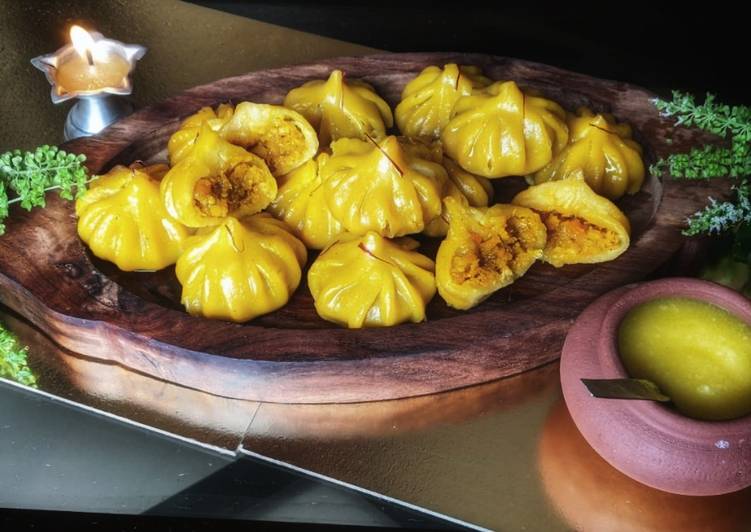Mango Modak. Mango modak recipe with step by step photos. Mango modak is a variation of modak recipes made with khoya or mawa. These modaks are prepared with fresh mango pulp, khoya (evaporated milk solids), sugar and flavored with cardamom powder.
 This easy dessert recipe makes for a perfect prasad recipe.
Prepared with two main ingredients: mango pulp and khoya, this lip-smacking sweet dish can be prepared in a jiffy that too without putting in much efforts.
Traditional Modak recipe with a flavour of mango & steamed with turmeric leaves.
You can cook Mango Modak using 7 ingredients and 8 steps. Here is how you achieve that.
This easy dessert recipe makes for a perfect prasad recipe.
Prepared with two main ingredients: mango pulp and khoya, this lip-smacking sweet dish can be prepared in a jiffy that too without putting in much efforts.
Traditional Modak recipe with a flavour of mango & steamed with turmeric leaves.
You can cook Mango Modak using 7 ingredients and 8 steps. Here is how you achieve that.
Ingredients of Mango Modak
- Prepare 200 g of alphonso mango pulp.
- It's 50 gms of mango chunks finely chooped(preferably sweet alphonso).
- Prepare 250 g of modak rice flour (different from normal rice flour).
- It's 100 g of jaggery.
- You need 50 g of sugar.
- It's 1 tablespoon of oil.
- Prepare 1 teaspoon of salt.
The aroma of turmeric leaves heightens the original aroma of the Modaks to create a delectable recipe which is a. Keep a small portion of the mango mixture on the center of this puri. Keep this in the modak mould and give the shape. Make all the modaks this way.
Mango Modak instructions
- I prefer adding no other flavours except for mango, to have a perfect mango taste hence not using any other ingredients like cardamon or rose water etc. First, add the grated fresh coxonut to a large wok/kadhai and roast it for about 3 minutes until a pinkinsh colour develops. Then add jaggery and sugar and keep mixing on medium flame until jaggery starts dissolving.
- As the jaggery dissolves, add in only 150 gms (out of 200 gms) of mango pulp and mix well, let thw mixture get dry (not too dry though), remove from flame and let this mixture cool well.
- Lets prepare the outer covering- for this first sieve the remainder mango pulp for any lumps. In a wok boil 1 cup of water, as the water comes to boil, add salt and oil, and then add the strained /sieved mango pulp to the water and mix well..
- Let it come to boil, lower the flame and add the modak rixe flour and keep mixing, you will see not all the mixture is absorbing water and sone is left dry, thats the correct texture we need. Cover and let it cook on very low flame for jus 2 minutes, (not more than 2 minutes). Turn off the flame and let it come to room temperature. It has tonbe pretty warm when u start kneading the dough out of this, Knead until a soft dough comes out of it, you can add a tablespoon of water if required.
- Meanwhile, the stuffing is nicely cooled, add the finely chopped sweet mango chunks. Take about a small to medium size ball of the dough and slightly flatten it, apply a 2-3 drops of oil on both sides and start making round katori shape just as we would make for momos. The thickness of this katori should be medium.
- Add a spoonful of stuffing at the centre of katori and start pleating the sides in circle using fore finger and middle finger, once all pleats are ready... Start bringing them together with the help of your little finger and palm of same hand, close at the top and create a mountain shape.
- Put the idli steamer on high flame, align allnthe modaks sligjtly apart from each other as they grow a bit in size post steaming. Cover with lid and let it steam for 15 minutes. You can test by touching the modak, if no dough stick to you finger, it's done..
- Traditionnaly we maharashtrian serve modak with pure desi ghee... It tastes yummy when served warm... Not too hot.. Not too cold... The covering need to be warm to bw metled instantly in your mouth. Garbish with a strand if kesar to give it a royal touch... And you seasonal fame mango modak are ready to be relished... 😉👍.
Sending this recipe to Priyas Virundhu , Gayathris cookspot for WTML Mango Modaks #modak. Cool and give shape of modak with greased mold. Mango modak a different version of modak. Modak is highly popular in Maharashtra on Ganesh Chaturthi. It is considered to be one of the favorite foods of the Lord Ganesha.